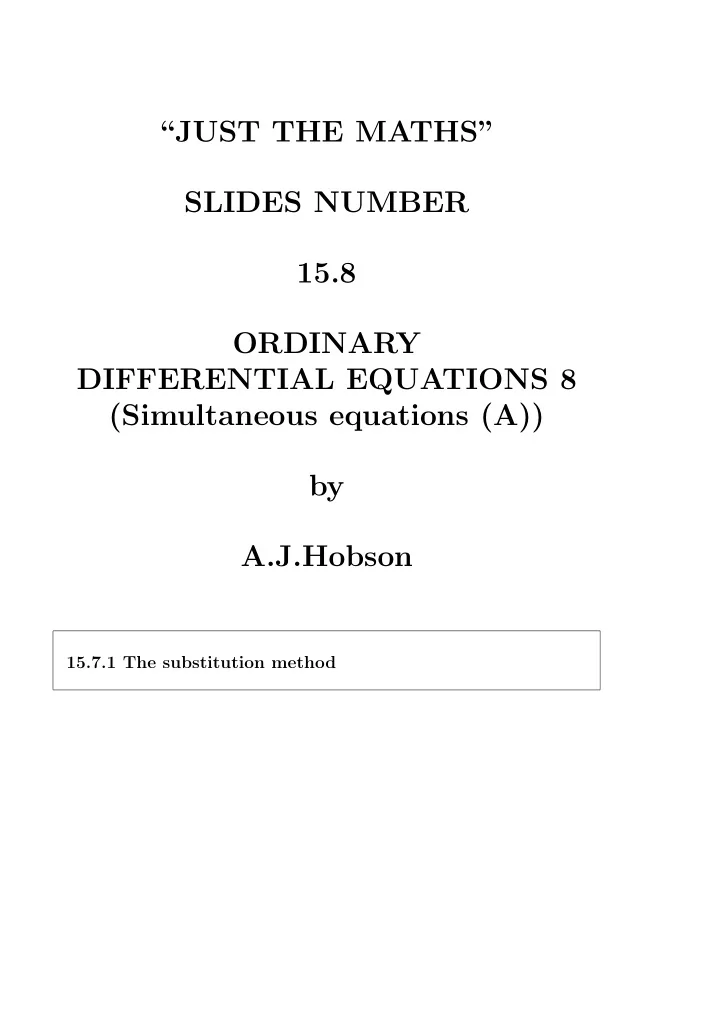

“JUST THE MATHS” SLIDES NUMBER 15.8 ORDINARY DIFFERENTIAL EQUATIONS 8 (Simultaneous equations (A)) by A.J.Hobson 15.7.1 The substitution method
UNIT 15.8 - ORDINARY DIFFERENTIAL EQUATIONS 8 SIMULTANEOUS EQUATIONS (A) 15.8.1 THE SUBSTITUTION METHOD We consider, here, cases of two first order differential equations which must be satisfied simultaneously. The technique will be illustrated by examples: EXAMPLES 1. Determine the general solutions for y and z in the case when 5d y d x − 2d z d x + 4 y − z = e − x , − − − − − (1) d y d x + 8 y − 3 z = 5 e − x . − − − − (2) Solution First, we eliminate one of the dependent variables from the two equations. In this case, we eliminate z . From equation (2), z = 1 d y d x + 8 y − 5 e − x . 3 1
Substituting this into equation (1), d 2 y 5d y d x − 2 d x 2 + 8d y d x + 5 e − x 3 +4 y − 1 d y d x + 8 y − 5 e − x = e − x . 3 That is, d 2 y − 2 d x 2 − 2 d y d x + 4 3 y = 8 3 e − x 3 3 or d 2 y d x 2 + d y d x − 2 y = − 4 e − x . The auxiliary equation is m 2 + m − 2 = 0 or ( m − 1)( m + 2) = 0 . The complementary function is Ae x + Be − 2 x , where A and B are arbitrary constants. A particular integral will be of the form ke − x , where k − k − 2 k = − 4 and hence k = 2. Thus, y = 2 e − x + Ae x + Be − 2 x . 2
From the formula for z in terms of y , z = 1 − 2 e − x + Ae x − 2 Be − 2 x � � 3 +1 16 e − x + 8 Ae x + 8 Be − 2 x − 5 e − x � � . 3 That is, z = 3 e − x + 3 Ae − x + 2 Be − 2 x . Note: The above example would have been more difficult if the second differential equation had contained a term in d z d x . In such a case, we could eliminate d z d x between the two equations in order to obtain a statement with the same form as Equation (2). 2. Solve, simultaneously, the differential equations d z d x + 2 y = e x , − − − − − (1) d y d x − 2 z = 1 + x, − − − − (2) given that y = 1 and z = 2 when x = 0. 3
Solution From equation (2), z = 1 d y . d x − 1 − x 2 Substituting into the first differential equation d 2 y 1 + 2 y = e x d x 2 − 1 2 or d 2 y d x 2 + 4 y = 2 e x + 1 . The auxiliary equation is therefore m 2 +4 = 0, having solutions m = ± j 2. The complementary function is A cos 2 x + B sin 2 x, where A and B are arbitrary constants. The particular integral will be of the form y = pe x + q, where pe x + 4 pe x + 4 q = 2 e x + 1 . We require that 5 p = 2 and 4 q = 1. 4
The general solution for y is y = A cos 2 x + B sin 2 x + 2 5 e x + 1 4 . Using the earlier formula for z , z = 1 − 2 A sin 2 x + 2 B cos 2 x + 2 5 e x − 1 − x 2 = B cos 2 x − A sin 2 x + 1 5 e x − 1 2 − x 2 . Applying the boundary conditions, 1 = A + 2 5 + 1 4 giving A = 7 20 and 2 = B + 1 5 − 1 2 giving B = 23 10 . The required solutions are therefore y = 7 20 cos 2 x + 23 10 sin 2 x + 2 5 e x + 1 4 and z = 23 10 cos 2 x − 7 20 sin 2 x + 1 5 e x − 1 2 − x 2 . 5
Recommend
More recommend